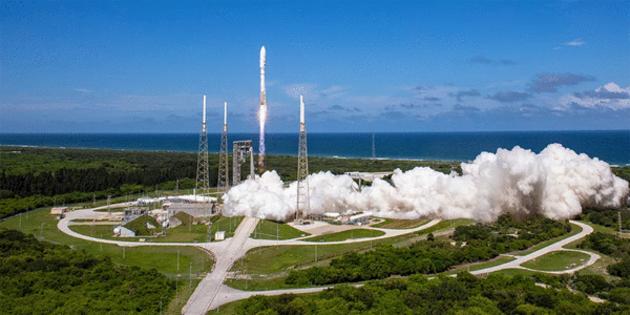United Launch Alliance, Amazon set first launch for SpaceX Starlink competitor Project Kuiper
Published in News & Features
A launch date is set for the first batch of what will be thousands of satellites for Amazon’s Project Kuiper as the company looks to play catch-up to SpaceX and its Starlink internet constellation.
United Launch Alliance is targeting a three-hour window that opens at noon Eastern time on April 9. It will send up 27 satellites on an Atlas V rocket from Cape Canaveral Space Force Station’s Space Launch Complex 41.
The KA-01 mission, which stands for Kuiper Atlas 1, will be ULA’s first launch of the year and the first of dozens Amazon has bought to get 3,232 satellites into low-Earth orbit by 2029.
SpaceX already has nearly 6,500 of its Starlink satellites in an operational orbit serving more than 5 million customers worldwide.
Amazon is primed, though, to start knocking out as many launches as it can. It has contracted to use eight of the remaining Atlas V rockets as well as an additional 38 on ULA’s new Vulcan rocket. In addition, the company has launches lined up with Jeff Bezos’ rocket company Blue Origin, European company Arianespace and even a couple of launches with SpaceX.
Amazon’s license from the Federal Communications Commission requires half of the satellites be placed in orbit by July 31, 2026.
So far, Amazon has flown two test satellites — in late 2023. That paved the way, though, for operational hardware production at company facilities in Washington. Also in the works is a new satellite processing facility at an 80-acre site at the Kennedy Space Center’s former Shuttle Landing Facility in Florida.
Amazon expects to begin satellite internet service to customers before years’ end.
“We’ve designed some of the most advanced communications satellites ever built, and every launch is an opportunity to add more capacity and coverage to our network,” Rajeev Badyal, vice president of Project Kuiper, said in a press release. “We’ve done extensive testing on the ground to prepare for this first mission, but there are some things you can only learn in flight.”
The design changed from the test satellites to this first operational batch, and it will be the first time it will be deploying them in such a large number.
“No matter how the mission unfolds, this is just the start of our journey, and we have all the pieces in place to learn and adapt as we prepare to launch again and again over the coming years,” he said.
The satellites are designed to orbit at an altitude of 392 miles circling the Earth about once every 90 minutes at more than 17,000 mph.
The 27 satellites will be the heaviest payload ever flown on an Atlas V and require ULA to launch it in its most powerful configuration using five strap-on solid rocket boosters.
Amazon has already begun to ship and process satellites for the next flight, also on an Atlas V, although ULA might prioritize the first national security launches of its new Vulcan that was finally certified last month by Space Force.
ULA is constructing a second vehicle integration facility at Cape Canaveral’s SLC-41, though, so it can process two rockets at the same time as it has a backlog of more than 70 launches to knock out.
_____
©2025 Orlando Sentinel. Visit orlandosentinel.com. Distributed by Tribune Content Agency, LLC.







Comments